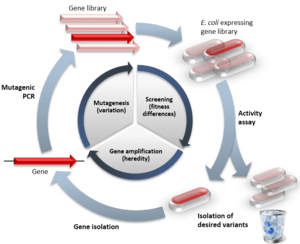Directed evolution facts for kids
Directed evolution (often called DE) is a clever way scientists use to make better enzymes and proteins. Think of enzymes as tiny helpers that speed up important jobs in our bodies or in factories. Scientists use DE to create new or improved enzymes for things like making medicines or cleaning products.
This method is a type of protein engineering. It copies how natural selection works in nature. In nature, living things with helpful traits survive and pass on their genes. Directed evolution does something similar, but in a lab.
The main idea is to take a gene and make many tiny changes (called mutations) to it. This creates a whole collection of slightly different genes. Then, scientists test these new genes to find the ones that make the best proteins. The best genes are then used to start the process all over again. This cycle of changing, testing, and picking the best is repeated many times.
Scientists can do this in two main ways:
- In vivo means "in living cells." This usually involves using tiny living things like bacteria or yeast.
- In vitro means "in a test tube" or "outside living cells." This happens in solutions or tiny liquid drops.
Testing more of these changed genes makes it more likely that scientists will find one with the exact properties they want.
Contents
How Directed Evolution Works
Using Living Cells (In Vivo)
When scientists use living cells, they put a different changed gene into each cell. Usually, these are bacteria or yeast cells. All the other genes in the cells stay the same.
The cells then make the protein from the new gene. This protein can be inside the cell or on its surface. Scientists can then test how well the protein works. Using cells is good because it helps scientists find proteins that will work well inside living things, like in our bodies.
Working Outside Cells (In Vitro)
Sometimes, scientists do directed evolution without using living cells. They make proteins or RNA (a molecule similar to DNA) in a test tube. This method has some cool benefits:
- Scientists can try out more extreme conditions, like very high temperatures or different liquids.
- They can make proteins that might be harmful to living cells.
- They can create a much larger collection of changed genes to test. This is because they don't need to put each gene into a cell.
Keeping the Gene and Protein Together
When a protein with the desired function is found, scientists need to make sure they also get the specific gene that created it. This is important because they need that gene to continue the process.
One way to do this is to link the gene (specifically, its RNA copy called mRNA) directly to the protein it makes. This happens right after the protein is built.
Another way is to keep the protein and its gene in the same tiny space, like a small droplet. Once the right gene is found, scientists can make many copies of it using a method called PCR. They can use the very best gene, or a mix of good genes, to start the next round of changes. Repeating these steps helps them create enzymes that are perfectly suited for their task.
A Special Award
An American engineer named Frances Arnold won the Millennium Technology Prize. She received this important award for her amazing work in pioneering directed evolution. Her discoveries have changed how we make many useful things.
Images for kids
See also
 In Spanish: Evolución dirigida para niños
In Spanish: Evolución dirigida para niños





